Feijoa sellowiana
Common Names: feijoa, pineapple guava
Family: Myrtaceae, the myrtle Family
Description
The
feijoa (pronounced fah-joe-ah) is a slow-growing, multi-stemmed
evergreen shrub. It can be trained to a small tree with a single trunk,
espaliered, or pruned to form a dense hedge or screen. Without any
pruning, the shrub may reach 15 ft (4.6 m) high and 15 ft (4.6
m) across. The egg-shaped leaves are 2-3 in (5-7.6 cm) long and silvery
underneath. The unusual flowers are edible and very attractive and are
sometimes seen gracing salads in fancy restaurants. They are about 1 in
(2.5 cm) across with fleshy white petals, showy scarlet stamens and
borne on the current year's growth. The edible fruits are round or
egg-shaped, 1-3 in (2.5-7.6 cm) long. The feijoas, as the fruits are
also called, have waxy blue-green or gray-green skins around a juicy
greenish white pulp.

Feijoa
flowers appear in early May and have thick fleshy petals that are sweet
and tasty. It's fun and refreshing to sit by a feijoa on a hot day and
munch on crunchy flowers before going inside to get something
substantial to eat.
Location
The feijoa is native to subtropical Paraguay, Uruguay, northern
Argentina and southern Brazil.
Culture
Feijoa is adaptable to most types of soil and doesn't require much
fertilizer.
Light: Full sun to part shade.
Moisture:
Thrives with little care in most well-drained soils. Usually
doesn’t
need supplemental watering except in very dry climates.
Hardiness: USDA
Zones 8 and 10. Feijoa is hardy to 10°F (-12° C) and
does best where
the winters are cool and the summers moderate with temperatures between
80-90° F (26-32° C). To produce fruit, feijoas need
100-200 chilling
hours below 45° F (7° C). Heat stress in the summer
may cause them to
drop fruit prematurely.
Propagation: Feijoas are best propagated by
cuttings or grafting from known cultivars. Seedlings grow slowly and
may not produce quality fruit.
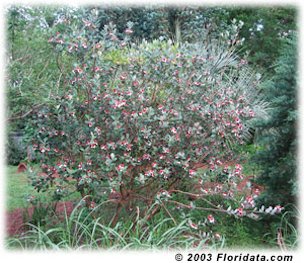
In North Florida feijoas ripen in September and over the years the deer
have acquired a taste for them.
Usage
Feijoas
respond well to pruning and can easily be shaped to any desired form.
They make an excellent hedge. The sweet, fleshy white and purplish
flower petals can be added to salads. Pluck them carefully and the
fruits will still develop. The fruits have a delicious minty-pineapple
flavor. Cut them in half and scoop out the pulp with a spoon. They will
drop when ripe, but you can pick them sooner and let them ripen in the
kitchen.
Features
Feijoas are not only attractive during all
seasons, they are a most versatile plant. They rarely have any disease
or pest problems. This is a good low maintenance shrub for hot dry
problem areas. If you are interested in fruit production purchase
cultivars selected for fruit quality, climate, time of ripening and
ability to self-pollinate (some cultivars can, some can't and some can
but with reduced quantity and quality of fruit).
It appears that
the feijoa is suffering a name change. Although in virtually every
publication you read, this plant is
Feijoa sellowiana but now it seems
to officially be
Acca sellowiana.
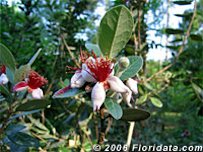 | 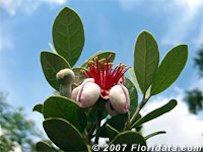 |
| Feijoa flowers | Feijoa edible flowers |
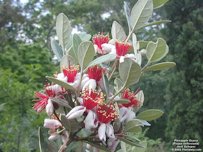 | 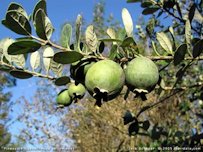 |
Feijoa (aka pineapple guava)
flowers | Ripe Feijoa fruits |